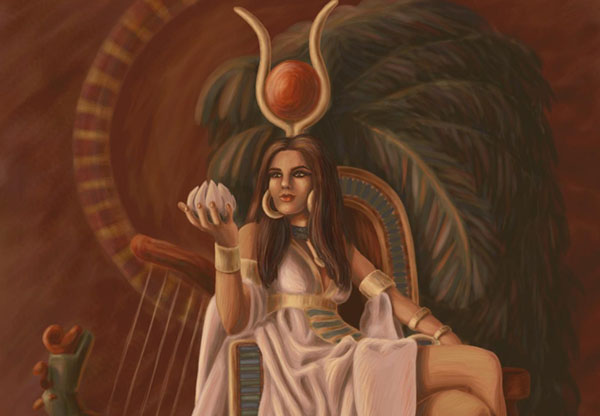Westerners regard masturbation and same-sex relations as taboo, but not the ancient Egyptians. Most of their creation myths are rooted in these practices.
Sexual references can be found in just about all aspects of ancient Egyptian life, as described in previous articles of this series: Sexuality in Ancient Egypt – Ancient Egyptian Family and Sexuality in Ancient Egypt – Egyptian Artwork. Even their creation myths contain sex, and various different kinds of sexual positions and practices.
For example, there is Min, the archaic god of procreation and Bes, the male deity associated with sexuality, fertility, music and magic. These gods are often depicted with large phalli and are usually associated with fertility. More prominent gods, however, would be those of the ancient Egyptian creation myth.
Most Unique Creation Myth
The ancient Egyptian story of creation can be, in Western eyes, depicted as a bit vulgar. In the story, the creator god Atum-Ra masturbates, thus creating the air and moisture god and goddess, Shu and Tefnut, respectively from his semen. Through sex (and might I add, incest) they merged to create Nut and Geb, the goddess and god of the sky and the earth. Nut and Geb also have a reputation for being fond of sexual activity. The artwork left behind describes them embracing so tightly that they eventually had to be separated by their father, Shu. He separated them because they were suffocating the world and nothing could exist between them.
Hathor: The Most Famous Female Deity
Another important infamously sexual deity is Hathor. She is often described as “one of the most fascinating deities in the Egyptian pantheon.” She usually portrayed as a beautiful woman with either a sun disc or horns on her head, or sometimes as a cow. Hathor is considered to be the mistress of all things relating to females and sexuality. She was the patron god of lovers and protector of women at childbirth. She was known for being the “Mother of All” and was sometimes depicted for being the hand of Atum-Ra during his “accomplishment” of masturbating to create the universe.
Hathor was so important to the ancient Egyptians, that a cult formed in her honor and made regular offerings to her. Some of these offerings include small shirts that possibly represent thanksgiving for a safe childbirth. Phallic objects were also offered and are thought to represent the need for healing of erectile dysfunction.
An important ceremony performed for Hathor was called the “Opening of the Womb.” This was performed for childless women hoping to become pregnant. From artwork, archaeologists learned ancient Egyptians would present Hathor an offering of a large representation of a penis (assumed to be a statue) that was labeled as the “Phallus that makes all things flourish.”
Homosexuality Amongst the Ancient Egyptians
Homosexuality was another theme in the ancient Egyptian pantheon. An example includes the story of the gods Seth and his brother, Horus. Notice not only the homosexual behavior, but also the incestuous relationship. Seth’s infatuation with his brother contains the earliest “pick up line”. Seth said to Horus, “How lovely is your backside!” In this relationship, Seth is described as the aggressor and is depicted as making Horus receive the sexual contact.
Some scholars believe that the relationship between Seth and Horus inspired men to engage in sexual activity with one another. For example, a text describing the relationship between Neferkare and his military commander Sasenet illustrates a sexual relationship. In this text, it is noted that they were lustful of each other and would often sneak out during the nighttime to be together. Perhaps the earliest recorded example of “Don’t Ask, Don’t Tell”!
Sex and the Afterlife
The ancient Egyptians even believed in sex in the afterlife. Some tombs contained sexual representations of women and described their role in the afterlife. Transformation back from the dead can be traced back to women as life givers. The cadavers of men were often accompanied with small statues which represented women in a sexual manner. It was the hope that these figurines would serve as an offering to Hathor to help them become alive again and/or be able to procreate in the afterlife. Even in the afterlife, it was the hopes of ancient Egyptians to be able to bear children.
In conclusion, sexuality has always been a topic that stimulates people of all ages and races most likely because it is a natural aspect of life. The ancient Egyptians associated every facet of their lives with sexuality, including family, beauty, creation myths and the gods of the pantheon, same sex relations, and rebirth in the afterlife. Because of the Judeo-Christian-Western ideals of modern times, it sometimes seems that the Egyptian principles were lewd and inappropriate. However, we must strive to understand that these people did have an ethical and moral background. Their most important attributes to civilization include striving as a society for many years, conquering many lands, making advancements in technology and architecture, and continuing progress in the medical field, just to mention a few. A fact not to be taken lightly includes their obscure sexual beliefs. This factor adds to the allure that is ancient Egypt.
References:
- Hassan, Fekri A. and Smith, Shelley J. 2002. Soul birds and heavenly cows: transforming gender in Predynastic Egypt. In: Nelson, Sarah Milledge and Rosen-Ayalon, Myriam, editors. In pursuit of gender: worldwide archaeological approaches. Walnut Creek: Altamira Press. p 43-65.
- Hornblower, G. D. 1943. The Egyptian fertility rite: postscript. Man 43: 26-34.
- Meskell, Lynn. 1999. Archaeologies of social life: age, sex, class et cetera in ancient Egypt. Massachusetts: Blackwell Publishers.
- Pinch, Geraldine. 1982. Offerings to Hathor. Folklore 93(2): 138-150.
- Reeder, G. 2000. Same-sex desire, conjugal constructs, and the tomb of Niamkhkhnum and Khnumhotep. World Archaeology 32(2): 193-208.








